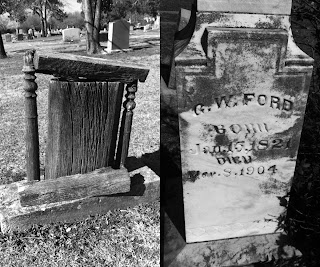Walking through the cemetery, any cemetery for that matter, is a history lesson on the community it serves. In Harry’s case, we can guess that the Butcher family came to Texas by wagon train over the Appalachians in the mid 1800’s. His family may have come to Allen shortly after the Houston-Central Railroad made Allen a relevant place in the 1870’s. Then again, he may have been a cattle driver from Kansas who met a pretty Texas lady and took up cotton farming.
We can only imagine his story but there were people alive in Allen at the turn of the last century who may have known Harry Butcher and some of their children are still alive today. So if you think about it, a person in Allen today could hear stories about growing up in the 1820’s. It is the ability to quickly reach back across generations and “touch history” that makes a visit to Allen’s Cemetery so interesting.
The Allen Cemetery was created on April 15, 1884 by Lodge 254 of the International Order of Odd Fellows on land donated by the Whisenant family. The IOOF was a benevolent fraternal organization dedicated to charitable causes that was brought to the U.S. from England in 1819. The oldest and most intriguing marker in the cemetery honors Rebecca Hamilton, who died in 1883. Hamilton was related to the Wetzel family that made its name building furniture. The unusual wooden headstone was carved by a family member and has long since fallen victim to Texas weather.
The cemetery, which sits across from the intersection of Main Street and McDermott, was maintained by the Allen Cemetery Association for many years. Three residents in particular; Dale Holt, Ed Lynge and Ted Summers, all worked to keep up the property and raise funds for its management. A lack of funding led to the cemetery falling into disrepair until the late 1980’s when the Allen City Council voted to acquire the property and operate it through the Allen Parks and Recreation Department. The rerouting of McDermott brought new attention to the cemetery, according to Sue Witkowski, who managed the property for the Parks and Recreation Department.
“We announced we would soon be raising the price of plots and almost immediately the entire cemetery sold out at the old price of $125 per plot.” Walking through the cemetery, Witkowski pointed out that the oldest graves are set against the creek at the eastern edge. Two of Allen’s oldest family names have prominent locations in the cemetery. R.B. Whisenant (1854-1937) and G.W. Ford (1821-1904) represent two pioneering families that traveled to the area by covered wagon before the Civil War. Whisenant’s grandson Ed Lynge still lives in the area and Ford’s grandson Pete was a lifelong resident and well known businessman.
Family plots around the cemetery with names like Miller, Summers, Curtis, Taylor, Leach and Compton all tell the stories of families that have figured in Allen’s history for over 100 years. Others tell the story of epidemics or fires that claimed the lives of family members and often small children.
The Allen Cemetery is at first a memorial to family members but it is also a history lesson for the rest of us and a visit to Harry Butcher’s grave may just get you thinking about life in this country 200 years ago.
